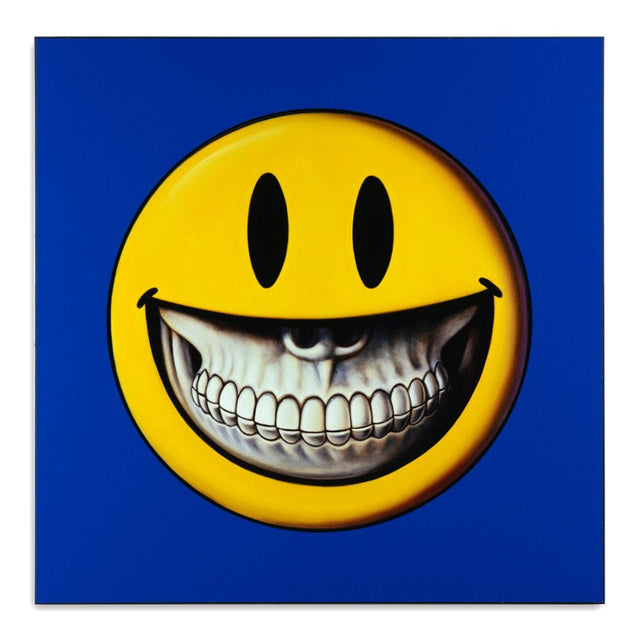
Smiley Face
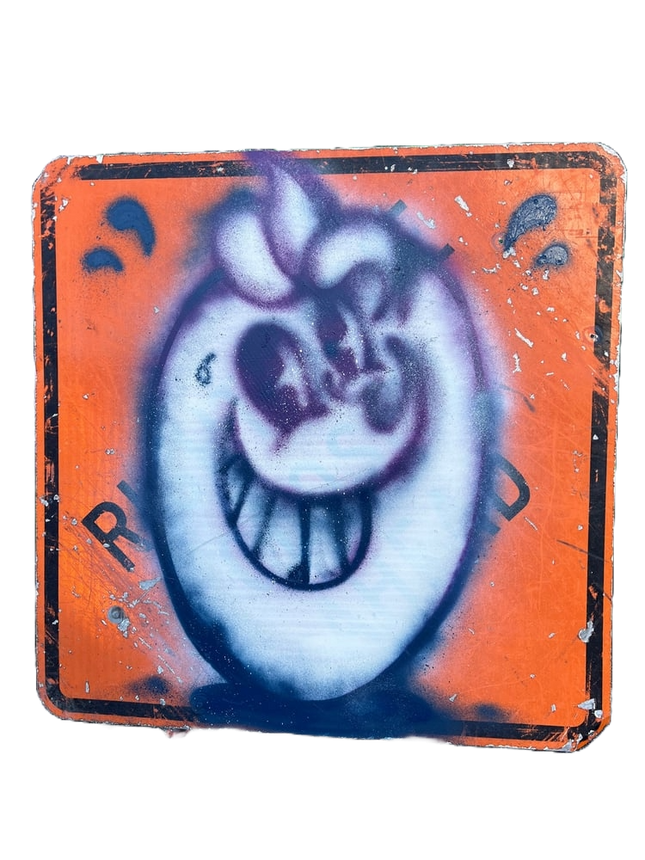
Atomik Lagos Original Street Sign Spray Painting by Atomik
Lagos Original Street Sign Spray Painting by Atomik Mixed Media Modern Graffiti Paint Pop Art on Real Metal Ready To Hang. 2023 Signed Original Painting on Reclaimed Metal City Road Construction Sign Artwork Size 36x36 of Spray Painted Smiling Atomik Orange In the vibrant world of modern graffiti and pop art, Atomik emerges as a unique voice, creating pieces that resonate deeply with art aficionados and street art enthusiasts alike. His 2023 artwork, titled "Lagos," is a prime example of his genius. Made on a reclaimed metal city road construction sign, this piece is not just a painting but a marriage of art and urban elements. Measuring 36x36 inches, "Lagos" is an ode to the urban environment from which Atomik draws inspiration. The centerpiece, the spray-painted smiling Atomik Orange, is instantly recognizable and evokes a sense of familiarity, bridging the gap between the street and the art gallery. The backdrop, a real metal city road construction sign, adds layers of authenticity and rawness to the piece. Its weathered appearance, marked with signs of wear and age, tells a story of its own, setting a contrasting stage for the vibrant and playful Atomik Orange. This painting does more than just showcase Atomik's technical prowess with a spray can. It challenges the boundaries of traditional art forms, blurring the lines between graffiti, pop art, and found object art. By choosing a reclaimed metal sign as his canvas, Atomik comments on the transient nature of urban life and the ever-evolving face of cities. For those who appreciate art that speaks to contemporary issues while staying rooted in traditional techniques, "Lagos" is a testament to Atomik's ability to capture the zeitgeist of modern urban culture. It's not just a piece of art; it's a conversation starter, a narrative, and a reflection of the times we live in.
$1,383.00
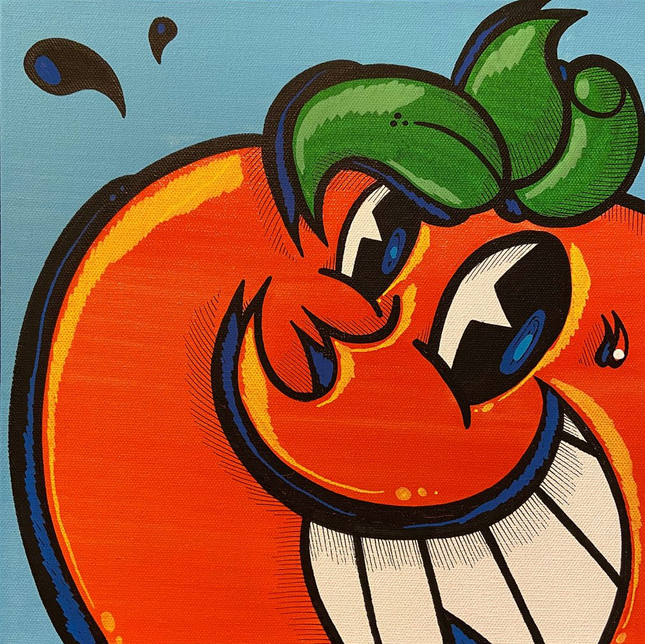
Atomik Untitled III Original Acrylic Painting by Atomik
Untitled III Original Acrylic Painting by Atomik One of a Kind Artwork on Canvas by Street Art Pop Artist. 2020 Signed Acrylic Painting Original Artwork Size 12x12 Smiling Atomik Orange Dated 2020, "Untitled III" stands as a shining example of Atomik's prowess in the realm of street and pop art. The original artwork, measuring a compact 12x12 inches, draws the viewer into its world through vibrant colors and unmistakable style. Crafted using acrylics on canvas, the painting displays the signature smiling Atomik Orange, a motif often associated with the artist. This signature element represents more than just a fruit; it is a symbol of the artist's connection to his hometown, Miami, and the city's iconic citrus history. Upon closer inspection, the intricate details and strokes in the painting reveal the artist's meticulous technique. The contrast of the bright orange against the calming blue backdrop brings forth a playful yet profound narrative, embodying the juxtaposition often found in street art—where vibrant murals spring to life against the muted urban landscapes. Atomik, with this piece, continues to showcase his ability to merge the worlds of street art and pop culture seamlessly. While the subject might appear simple at first glance, its execution, with layered tones and intricate detailing, speaks to the depth and complexity of the artist's vision. Collectors and aficionados of street art will instantly recognize the significance of this one-of-a-kind artwork. Not only does it capture Atomik's unique style and essence, but it also immortalizes a moment in time when art, culture, and history converge on a single canvas. "Untitled III" isn't just a painting; it's a narrative, a statement, and an experience unto itself.
$637.00
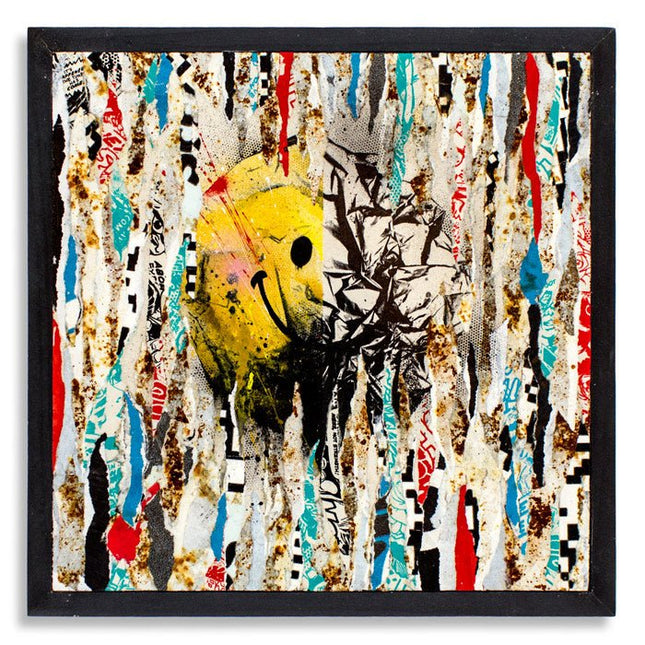
Meggs Torn Up Original Reclaimed Spray Paint Acrylic Painting by Meggs
Torn Up Original Painting Aerosol, Acrylic, Screenprint & Reclaimed Posters on Wood by Meggs Graffiti Street Artist Modern Pop Art. 2012 Signed Original Mixed Media Spray Paint Acrylic Reclaimed Items Painting Framed Artwork Size 17.5x17.5 Framed
$2,861.00
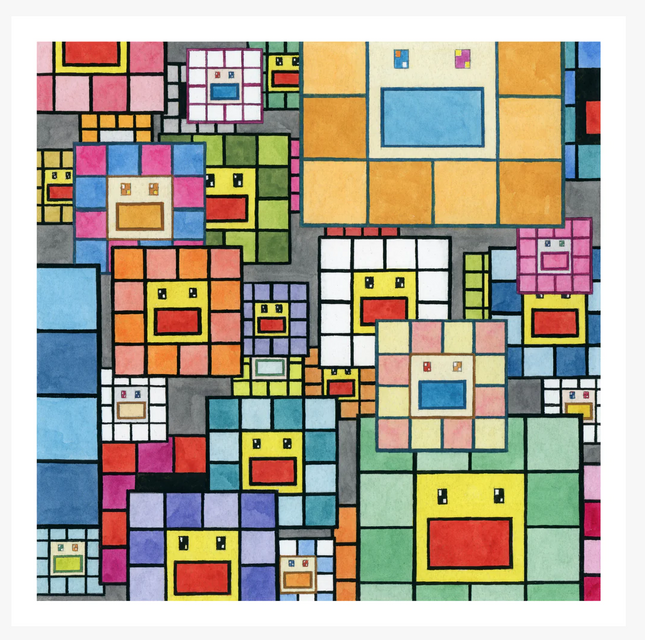
Adam Lister Tribute to Murakami #1 Original Watercolor Painting by Adam Lister
Tribute to Murakami #1 Original Watercolor Painting by Adam Lister One of a Kind Artwork on 140lb Cold-Press Watercolor Fine Art Paper by Street Art Pop Artist. 2023 Signed Date & Title on Back Watercolor Original Painting Size 8.5x8.5 Adam Lister's Watercolor Ode to Murakami "Adam Lister's Tribute to Murakami #1" is a vibrant homage to the intricate dance of color and form seen in the works of Takashi Murakami, one of the most celebrated figures in contemporary art. Lister, with this original watercolor painting on 140lb cold-press watercolor fine art paper, delves into the realm of pop art through a street art lens, offering a unique and compelling interpretation that captures the playful essence and graphic boldness associated with Murakami's style. Dated and signed in 2023, the artwork, sized at a precise 8.5x8.5 inches, presents a meticulous arrangement of hues and shapes, revealing Lister's mastery over the medium and his ability to translate complex visual languages into his distinct voice. Lister's work exemplifies the principles of Street Pop Art & Graffiti Artwork through its accessible imagery, clear lines, and the profound depth of its apparent simplicity. The piece resonates with the vibrancy of street art and the keen sensibility of pop art, capturing the observer's imagination with its playful geometry and familiar yet fresh aesthetic. Each color block within the piece is meticulously placed, contributing to an overall harmony. At the same time, the apparent influence of digital pixelation and 8-bit graphics nods to the modern era's intersection with traditional techniques. The Intersection of Digital and Traditional in Modern Art The painting serves as a reflection on the intersection of digital and traditional media in modern art. Lister's choice to employ watercolor, a medium often associated with more classical art forms, in depicting a decidedly modern and pop-culture-oriented subject is a conscious celebration of the versatility and enduring relevance of traditional artistic methods in the digital age. This blending of old and new is at the heart of Lister's approach, which frequently involves reimagining iconic images from popular culture through the lens of his geometric abstraction. In "Tribute to Murakami #1," Lister plays with the concept of pixelation, where each square serves as a reminder of the digital screens that dominate contemporary life. However, using watercolors, he breathes life into the pixels, transforming them into a fluid and dynamic arrangement that seems to pulsate with organic energy. This deliberate juxtaposition elevates the piece beyond mere replication, allowing Lister to explore themes of technology, art history, and visual perception within a unified work. Collectibility and Cultural Significance of Lister's Work The collectibility and cultural significance of Adam Lister's "Tribute to Murakami #1" are intrinsic to its creation. As a signed, one-of-a-kind piece, it occupies a unique place in the art market, appealing to collectors who value the originality and thoughtfulness of Lister's vision. The fact that the title and date are inscribed on the back further authenticates the work, ensuring that it is recognized and valued as a genuine Lister creation. Lister's work, particularly this piece, contributes to the ongoing dialogue between street art and the broader art world. It encapsulates the essence of Street Pop Art & Graffiti Artwork, which often seeks to break down barriers between 'high' and 'low' culture, questioning the hierarchies that traditionally govern art valuation. In "Tribute to Murakami #1," Lister respects a figure known for doing precisely that while establishing his place within the contemporary art narrative. In essence, "Tribute to Murakami #1" by Adam Lister celebrates the convergence of street art sensibilities with pop culture references rendered through watercolor. This piece is a testament to the evolving nature of art in the public domain, the continual blurring of lines between different movements, and how contemporary artists like Lister reshape the landscape of visual culture. Through works like this, Lister not only honors the legacy of icons like Murakami but also carves out his niche within the vibrant tapestry of modern art.
$3,764.00
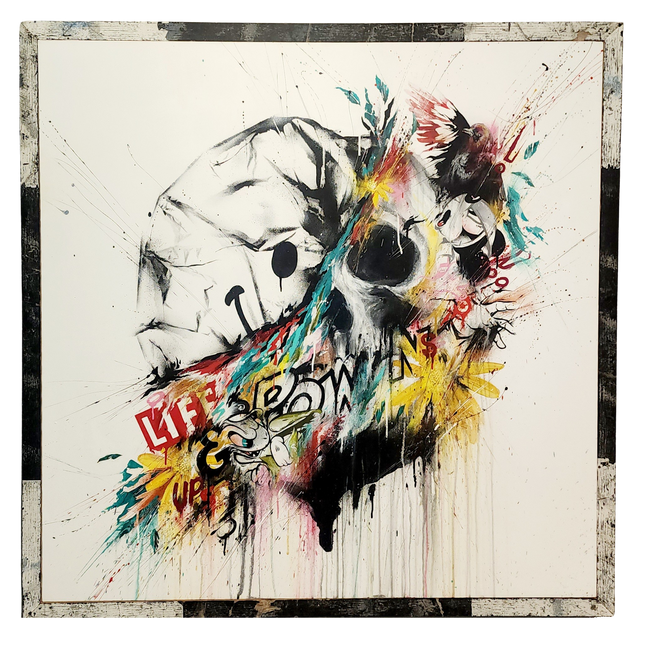
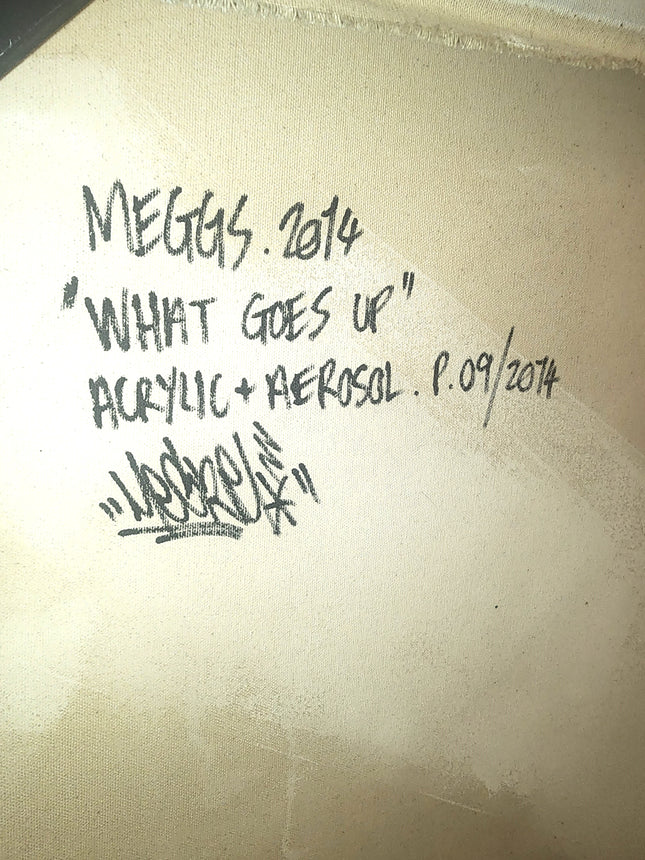
Meggs What Goes Up Original Spray Paint Acrylic Painting by Meggs
What Goes Up Original Spray Paint Acrylic Painting by Meggs One of a Kind Artwork on Canvas with Custom Reclaimed Wood Frame by Street Art Pop Artist. 2014 Signed Acrylic & Spray Paint Painting Original Canvas in Artist Hand Made Reclaimed Wood Frame Artwork Size 49x49. From Spoiled Rotten Show. Exploring the Dynamic Essence of Meggs' "What Goes Up" "What Goes Up" is an original acrylic and spray paint painting by the acclaimed street pop artist Meggs that encapsulates the dynamism and energy of his work. Created in 2014, this artwork reflects Meggs' signature style, which harmoniously blends street art's rawness with pop art's vividness. This one-of-a-kind artwork is a statement piece and a storytelling canvas that explores themes prevalent in Meggs' oeuvre, such as the constant struggle between opposing forces and the transient nature of success and failure. The painting measures 46x46 inches and is housed in a custom reclaimed wood frame handcrafted by the artist. Reclaimed wood adds an eco-conscious dimension to the artwork, reinforcing Meggs' interest in sustainability and the repurposing of materials. This choice of framing also accentuates the urban and gritty feel of the painting, resonating with the street art tradition of using found objects and spaces. Artistic Techniques and Visual Impact in "What Goes Up" Meggs employs acrylic and spray paint in "What Goes Up," showcasing his adeptness at using traditional and non-traditional media. The acrylic provides depth and texture, while the spray paint offers a sense of immediacy and spontaneity intrinsic to graffiti artwork. The painting is a cacophony of colors, bursting forth from a central point, suggesting an explosion of energy and creativity. The colors are not just randomly splashed across the canvas; they are meticulously layered to create a visual impact that is both chaotic and controlled. The artwork features a skull motif, a recurring element in Meggs' art, which often symbolizes the transient nature of human existence and the cyclical nature of life. However, in "What Goes Up," the skull is juxtaposed with vibrant colors and comic-style exclamations, which could be interpreted as a commentary on the superficiality of popular culture and the fleeting nature of fame and success. The skull seems to be disintegrating or exploding into an array of colors and shapes, a powerful visual metaphor for the inevitable downfall that follows a rise to the top. Cultural Commentary and the Essence of Street Pop Art The painting's title, "What Goes Up," hints at the adage "what goes up must come down," suggesting a narrative of ascent and descent. Meggs often infuses his Street Pop Art and graffiti Artwork with philosophical musings and critical observations of society. The work symbolizes the cyclical patterns of life and can be seen as a reflection of the transient nature of success or the hubris that often precedes a fall. The artist's use of text in the painting, rendered in a comic book style, adds a layer of communication with the viewer, inviting them to ponder the deeper meanings behind the vibrant facade. The piece is a testament to the artist's ability to navigate the space between gallery and street art, making it accessible to a diverse audience. The inclusivity of street art is evident in Meggs' work, where the public space becomes a canvas for dialogue, and the art becomes a part of the everyday urban landscape. "What Goes Up" is not just a visual spectacle but also a piece of cultural commentary, encapsulating the ethos of street art and its role in contemporary discourse. "What Goes Up" is a prime example of Meggs' impact on the field of street art and his contribution to the broader pop art movement. The painting manifests the artist's dedication to craft, concept, and commentary. Through the integration of various artistic techniques and the strategic use of reclaimed materials, Meggs has created an artwork that is both a visual feast and a conceptual powerhouse. The significance of Meggs' work lies in its ability to resonate with viewers on multiple levels. This work can be appreciated for its aesthetic qualities and ability to evoke emotion and provoke thought. As a piece of Street Pop Art and graffiti Artwork, "What Goes Up" embodies the spirit of this genre, which continues to push the boundaries of art and its place in society. It remains a poignant piece within Meggs' body of work and within the larger conversation of contemporary art.
$10,000.00







